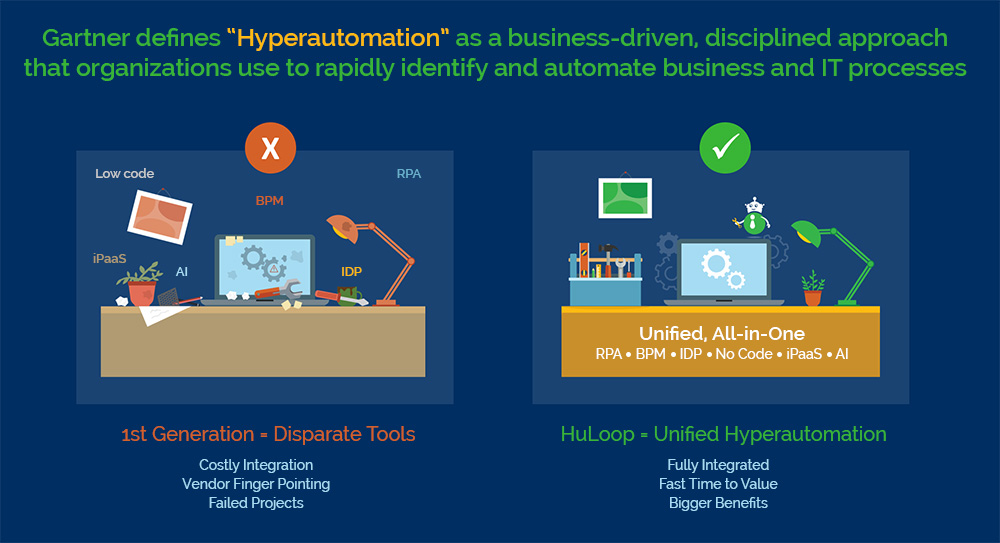
Unified Hyperautomation: The Ultimate Stitch Fix
SHARE THIS:
By Chandra Kanive, HuLoop CTO
For the last several years, first generation automation software has provided companies with the ability to optimize various aspects of their business. The problem? They were mostly point solutions such as robotic process automation (RPA), business process management (BPM) and intelligent document processing (IDP) and had to be stitched together if an organization required multiple capabilities. This caused many enterprises to wonder if the “juice was worth the squeeze,” given the inherent challenges that accompany stitching together disparate tools. In addition, many of the point solutions were developed prior to artificial intelligence (AI) or machine learning (ML) becoming prevalent and as a result, weren’t built to leverage more recent technology.
Next generation “Unified Hyperautomation” platforms, however, offer far more robust and integrated automation capabilities — including data and document processing — while utilizing AI/ML technology for more enhanced automation services.
What is Hyperautomation?
According to analyst firm Gartner, hyperautomation is “a business-driven, disciplined approach that organizations use to rapidly identify, vet, and automate as many business and IT processes as possible. Hyperautomation involves the orchestrated use of multiple technologies, tools, or platforms, including artificial intelligence (AI), machine learning, event-driven software architecture, robotic process automation (RPA), business process management (BPM) and intelligent business process management suites (iBPMS), integration platform as a service (iPaaS), low-code/no-code tools, packaged software and other types of decision, process, and task automation tools.”
Where It Started: First Generation Automation
While transformative, first-generation automation software effectively consisted of disparate tools. A company, for example, would use an RPA vendor for their initial automation needs. Later, they might discover the need for process orchestration or data automation and use separate vendors to address those needs.
Over time, the company’s automation initiatives would consist of several disparate solutions that had to be “stitched” together to try to meet the organization’s expanding automation needs.
Unfortunately, using all these disparate technologies together can often result in costly integrations of different platforms, vendor finger pointing, and even failed projects. And even if these stitched together solutions worked, they were often very fragile. Unified hyperautomation platforms, however, both automate and convey data about those automations in one location, providing organizations with valuable and actionable business information.

Automation software companies that started out by offering single point solutions most likely were developed before the era of AI. After years of focusing on just automation — and building an architecture that was for a point solution — it’s incredibly challenging for them to now incorporate AI capabilities because that would mean reworking their existing foundations.
Enter Next Generation Unified Hyperautomation
Today’s unified hyperautomation platforms are much more nimble and agile than the first-generation automation tools and as a result, can more easily incorporate new technology into the platform because they were built to do just that — and that means client organizations benefit from more capabilities from the get-go — or as they need them going forward.
Unified hyperautomation platforms effectively provide a “one-stop shop” for enterprises that don’t want vendor proliferation, but need a broad array of automation capabilities. Comprehensive hyperautomation platforms offer functionality such as:
- Data-Driven Process Discovery – Generates understanding of people, processes, and technologies are being used and what happens in between them.
- Robotic Process Automation (RPA) – Building, deploying and managing software robots aka bots or digital assistants that emulate what humans would otherwise need to do.
- Intelligent Document Processing (IDP) – Loading, digitizing, classifying, extracting, redacting, validating and exporting intelligence from documents and files.
- Business Process Automation (BPA) – Orchestration and automation of complex processes across disparate systems.
- Intelligent Data Automation (IDA) – Collecting, validating and publishing data automatically.
- Software Test Automation (STA) – Creating, executing and analyzing an array of tests comparing actual expected outcomes.
A significant advantage of unified hyperautomation platforms is that this broader arsenal of tools is designed to work together. Complex business processes can be orchestrated leveraging RPA, BPM, IDP, data automation and more to match how work really gets accomplished. Moreover, a unified platform provides actionable insights, in the form of a “command center,” so enterprises can monitor all automations that are occurring across various cross-functional departments.
Scalable for Today and Tomorrow
While unified hyperautomation is essential for companies of all sizes, a comprehensive single vendor solution is particularly beneficial for small and medium-sized (SMB) businesses as it is easier to leverage across an organization and avoids the integration challenges that occur with multi-vendor solutions.
These platforms offer both vertical scaling and horizontal scaling. With horizontal scaling, organizations can add more users across more departments as needed. Organizations can add more features, such as business process management or intelligent document processing, that exist within the platform, or seamlessly leverage features that plug and play into the platform when they want it in their ecosystem. Today’s robust cloud infrastructures provide elastic vertical scaling.
Mirroring the Enterprise Resource Planning (ERP) Model
Over the past two decades, most enterprises have invested in broad-based ERP solutions to harmonize how business functions can work together. ERP vendors may not always be best-in-class across every module or functionality — it’s quite possible there are better third-party order management or accounts receivable solutions that exist. However, most organizations have chosen to refrain from stitching together such best-of-breed modules, and decided it was a better organizational decision to leverage one comprehensive platform with functionality designed to work together.
Similarly, there is no shortage of best-of-breed vendors across the RPA, IDP, and BPM spaces among others, but the organizational benefits of a single, integrated hyperautomation provider outweighs the singular benefits of an extra feature here or there.
Building Efficiencies
By using a unified hyperautomation platform vs disparate solutions, companies benefit from having all the critical automation capabilities in one place. Otherwise, admins are frequently switching context, spending time manually switching between tools, and there is fragmentation across processes.
For example, in a typical enterprise organization, there could be different automation needs for the finance department vs. sales, marketing, and supply chain. In a unified hyperautomation platform, those varying automation needs could be performed, managed and optimized in a single solution.
Conclusion
First generation point solutions for automation have served their purpose, but they must now give way to the next generation of digital transformation. Unified hyperautomation platforms provide integration and scalability for enterprises of all sizes, while offering comprehensive capabilities in one platform. Housed in one system, companies benefit from centralized management and visibility, while eliminating the integration challenges, vendor finger pointing and even failed projects that occur when stitching together disparate tools. Unified hyperautomation platforms are built with AL/ML capabilities already incorporated and were developed to easily and nimbly add additional technology as market needs change.
If you are interested in learning more about HuLoop’s unified hyperautomation platform, please click here.
About the Author: Chandra Kanive
 Chandra Kanive serves as HuLoop Automation’s Chief Product and Technology Officer, and he comes with more than 20 years of senior leadership and technology experience. He has successfully led global Engineering, Product, and Operations organizations at top technology companies. Prior to HuLoop, he most recently was Senior Vice President of Engineering at Pendella Technologies. Kanive has a broad set of leadership experiences from well-known technology companies like Nortel, Siebel, Salesforce, IBM, Apple, and Model N.
Chandra Kanive serves as HuLoop Automation’s Chief Product and Technology Officer, and he comes with more than 20 years of senior leadership and technology experience. He has successfully led global Engineering, Product, and Operations organizations at top technology companies. Prior to HuLoop, he most recently was Senior Vice President of Engineering at Pendella Technologies. Kanive has a broad set of leadership experiences from well-known technology companies like Nortel, Siebel, Salesforce, IBM, Apple, and Model N.
Kanive holds an executive MBA from UCLA Anderson School of Management, an MS in Computer Science from the University of Nebraska-Lincoln, and a diploma in Leadership Principles from Harvard Business School Online. He completed his BS in Computer Science from the University of Mysore in India. Furthermore, he has received specialized certifications in Artificial Intelligence/Machine Learning from UC Berkeley and Stanford University and several professional certifications in Blockchain, Big Data, and other emerging technologies.
About HuLoop Automation
Based in the Sacramento, California area, HuLoop Automation offers an AI-powered, no-code, unified automation platform that helps clients drive transformation, achieve revenue growth, cost savings, and productivity gains by automating mundane, repetitive activities that we don’t want our people doing. This platform brings next generation hyperautomation innovation across several key solution areas: 1.) data driven process and task discovery, 2.) business process automation (BPA), 3.) robotic process automation (RPA), 4.) intelligent document processing (IDP), 5.) software test automation (TA) and 6.) intelligent data automation (IDA). HuLoop is used across the enterprise by both businesspeople and technology experts. Learn more at www.huloop.ai and follow HuLoop on LinkedIn, Facebook and Twitter.